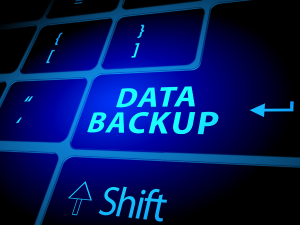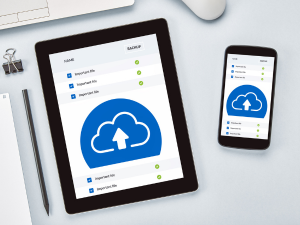
TLDR: Disaster recovery software is not optional. The right tools protect your data, minimize downtime, and safeguard your reputation. The features you must prioritize are automated backups, rapid recovery, cloud integration, built-in security, and simple management.
It doesn’t take a hurricane to stop a business. One power surge, one ransomware email, or one server failure can freeze operations without warning.
The U.S. Small Business Administration warns that 25% of businesses never reopen after a major disaster (SBA).
Disaster recovery (DR) software ensures your business can recover quickly from outages, ransomware, hardware failures, or natural disasters. It is the difference between a temporary setback and permanent closure.
Automated Backups
Manual backups fail because they rely on human memory. Staff forget to run them, drives get misplaced, or key files get skipped. Automated backups eliminate these risks.
What to demand:
- Policy-driven scheduling so backups happen without staff involvement.
- Comprehensive coverage across servers, desktops, and cloud-based data.
- Verification tools that check each backup is complete and usable.
- Version control that stores multiple points in time.
Why it matters: If your backups are inconsistent, you may discover critical gaps at the exact moment you need them most. Automation ensures that never happens.
Software examples:
Rapid Recovery
Backups are meaningless if recovery takes days. Customers will not wait, employees cannot work, and losses mount quickly.
Key terms:
- Recovery Point Objective (RPO): How much data you can lose between the last backup and the disaster.
- Recovery Time Objective (RTO): How long you can afford to be down before serious harm occurs.
Capabilities to look for:
- Booting directly from backups for immediate recovery.
- Fast restoration of entire servers, applications, or single files.
- Orchestration that restores systems in the right order.
Why it matters: Small businesses rarely survive prolonged downtime. Disaster recovery software that reduces RTO and RPO can literally save the company.
Software examples:
Cloud and Hybrid Storage

Keeping all backups in one location is dangerous. A flood, fire, or break-in can erase them. Cloud integration adds resilience by storing copies offsite.
What strong cloud integration includes:
- Hybrid backup (local for speed, cloud for safety).
- Geo-redundancy across multiple data centers.
- Compression and deduplication to control costs.
- Remote restore when your office is inaccessible.
Why it matters: Cloud integration ensures that even if your primary site is destroyed, your data lives on.
Software examples:
Built-In Security
Backups are now a target. Many ransomware attacks are designed to corrupt backup files so companies have no choice but to pay.
Non-negotiable protections:
- Encryption during storage and transfer.
- Multi-factor authentication for administrators.
- Immutable backups that cannot be altered or deleted.
- Role-based permissions limiting recovery rights.
- Anomaly detection to flag ransomware activity.
Why it matters: If attackers can reach your backups, you do not have a recovery plan—you have a vulnerability.
Software examples:
Easy Management
In a crisis, no one should be digging through a 300-page manual. Disaster recovery software must be simple enough to use under stress.
Features that make a difference:
- A clear dashboard showing backup and system health.
- Real-time alerts if backups fail.
- Guided restore workflows.
- Role-based views tailored to IT staff, managers, or compliance officers.
Why it matters: A tool that confuses your team will not deliver in a real emergency. Ease of use is just as important as technical power.
Software examples:
Advanced Capabilities for Higher Resilience
Some disaster recovery platforms go beyond the basics. These features are worth considering, especially for industries with compliance or uptime requirements:
- Automated testing to validate recovery processes.
- Granular restores to recover specific files or emails instantly.
- Compliance reporting to satisfy HIPAA, PCI, or SOX regulations.
- Geo-failover to run operations from a different region during a disaster.
These capabilities may not be needed by every business, but for regulated or data-intensive companies, they provide crucial peace of mind.
How to Evaluate Solutions
Buying disaster recovery software should not be about the biggest brand name. It should be about what fits your goals, budget, and infrastructure.
Evaluation checklist:
- Define your RTO and RPO targets.
- Test recovery with real data in your environment.
- Confirm integrations with your existing servers, SaaS platforms, and endpoints.
- Evaluate scalability for future growth.
- Calculate total cost, including licenses, cloud storage, and support.
FAQ
1. Why do small businesses need disaster recovery software?
Because downtime and data loss are more costly for small companies, and many never reopen after a major disruption.
2. How often should disaster recovery plans be tested?
At least twice a year. Testing ensures backups can actually be restored.
3. Can cloud backup replace local backup?
No. Cloud provides resilience, but local backups provide speed. The best approach is hybrid.
4. How do I know if a solution is right for me?
Test it in your environment, confirm it meets your RTO/RPO goals, and ensure it integrates with your systems.
5. What happens if my backups are compromised?
If your backups are not secure, recovery may be impossible. That’s why encryption, immutability, and ransomware detection are essential.
Build Your Disaster Recovery Strategy
Every hour of downtime is expensive, and some businesses never reopen after major disruptions. Disaster recovery software ensures that when trouble strikes, your business keeps moving.
At Inland Productivity Solutions, we help businesses across California design disaster recovery plans that actually work. From choosing the right software to building secure infrastructure, we make sure your systems are protected and recoverable.
Contact us today to build a disaster recovery strategy you can rely on.


